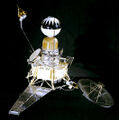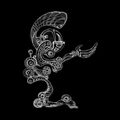Template:Selected anniversaries/January 28: Difference between revisions
No edit summary |
No edit summary |
||
| Line 15: | Line 15: | ||
||1830: Samuel Thomas von Sömmerring dies ... physician, anatomist, anthropologist, paleontologist and inventor. Sömmerring discovered the macula in the retina of the human eye. His investigations on the brain and the nervous system, on the sensory organs, on the embryo and its malformations, on the structure of the lungs, etc., made him one of the most important German anatomists. Pic. | ||1830: Samuel Thomas von Sömmerring dies ... physician, anatomist, anthropologist, paleontologist and inventor. Sömmerring discovered the macula in the retina of the human eye. His investigations on the brain and the nervous system, on the sensory organs, on the embryo and its malformations, on the structure of the lungs, etc., made him one of the most important German anatomists. Pic. | ||
||1838: James Craig Watson born ... astronomer. He discovered 22 asteroids, beginning with 79 Eurynome in 1863. He was a strong believer in the existence of the planet Vulcan, a hypothetical planet closer to the Sun than Mercury, which is now known not to exist Pic. | |||
File:Sekiya Seikei.jpg|link=Sekiya Seikei (nonfiction)|1855: Geologist [[Sekiya Seikei (nonfiction)|Sekiya Seikei]] born. He will be one of the first seismologists, influential in establishing the study of seismology in Japan and known for his model showing the motion of an earth-particle during an earthquake. | File:Sekiya Seikei.jpg|link=Sekiya Seikei (nonfiction)|1855: Geologist [[Sekiya Seikei (nonfiction)|Sekiya Seikei]] born. He will be one of the first seismologists, influential in establishing the study of seismology in Japan and known for his model showing the motion of an earth-particle during an earthquake. | ||
Revision as of 12:15, 28 January 2019
1540: Mathematician and fencer Ludolph van Ceulen born. He will spend a major part of his life calculating the numerical value of the mathematical constant π.
1855: Geologist Sekiya Seikei born. He will be one of the first seismologists, influential in establishing the study of seismology in Japan and known for his model showing the motion of an earth-particle during an earthquake.
1883: Electrical engineer Nikola Tesla invents method of converting alternating current (AC) into Gnomon algorithm functions, revealing new techniques for preventing crimes against mathematical constants.
1884: Physicist and explorer Auguste Piccard born. He will make record-breaking hot air balloon flights, with which he will study Earth's upper atmosphere and cosmic rays, and invent of the first bathyscaphe.
1885:Pilot, engineer, and alleged time-traveller Henrietta Bolt predicts that Auguste Piccard will "grow up to reach amazing heights, then go on to reach amazing depths."
1950: Mathematician, theorist, and academic Nikolai Luzin dies. He contributed to descriptive set theory and aspects of mathematical analysis with strong connections to point-set topology.
1961: Brainiac Explains lecture series spends ten weeks on New York Times bestseller list.
1962: Ranger 3 space probe misses the moon by 22,000 miles (35,400 km).
1988: Physicist Emil Julius Klaus Fuchs dies. He was convicted of supplying information from the Manhattan Project to the Soviet Union during and shortly after the Second World War.
2018: Signed first edition of an excerpt from "Burglars" sells for two and a half million dollars in charity auction to benefit victims of crimes against mathematical constants.
2016: Steganographic analysis of Lend a Hand unexpected reveals "at least half a megabyte" of encrypted data relating to organic golem technology.










